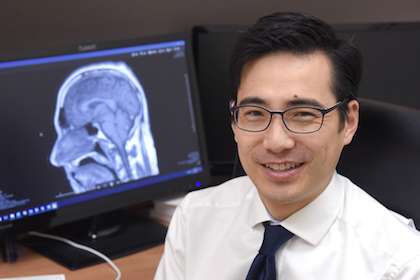Dr. Arthur Hong's study explores why physicians often order unnecessary radiographic imaging for common headaches and back ailments. Credit: UT Southwestern
Do you really need that MRI?
Your doctor may order an MRI based on factors other than your actual medical need for imaging, researchers in UT Southwestern's Center for Patient-Centered Outcomes Research found. Their study in JAMA Internal Medicine showed that a physician's prior image-ordering habits, as well as ownership of the equipment, were strong indicators of unnecessary imaging orders.
"Whether or not you get unnecessary imaging is partly explained by how much unnecessary imaging the clinician orders in general and whether or not the clinician owns the imaging equipment," said lead author Dr. Arthur Hong, Assistant Professor of Internal Medicine and Clinical Sciences at UT Southwestern Medical Center. "For patients who got an MRI but did not need one, which doctor they went to mattered more than the injury or symptom that they had. With people more on the hook for the costs of their care, it's increasingly important for physicians to offer financially responsible care."
Uncomplicated back pain and uncomplicated headaches are two of the most common reasons patients with health insurance received low-value, or unnecessary, imaging such as X-rays, computed tomography (CT), or magnetic resonance imaging (MRI). Previous studies have shown that this kind of wasteful care may account for up to one-third of all medical expenditures. In addition, low-value services can trigger downstream cascades of unnecessary care and clinical harm, said Dr. Hong, a Texas Health Resources Clinical Scholar.
The JAMA Internal Medicine study examined the records and characteristics of 100,977 primary care physicians, specialist physicians, and chiropractors in search of predictors for unnecessary back pain and headache image ordering. They found:
- Chiropractors and specialists were more frequent back pain imagers.
- Primary care physicians who ordered more back pain imaging also ordered more headache imaging.
Next steps for researchers include examining other nonclinical factors that continue to influence clinician practice habits, and ultimately exploring how to help patients and clinicians make better clinical decisions together.
More information: JAMA Intern Med. Published online September 25, 2017. DOI: 10.1001/jamainternmed.2017.4888 , jamanetwork.com/journals/jamai … /fullarticle/2653911
Journal information: JAMA Internal Medicine
Provided by UT Southwestern Medical Center






















